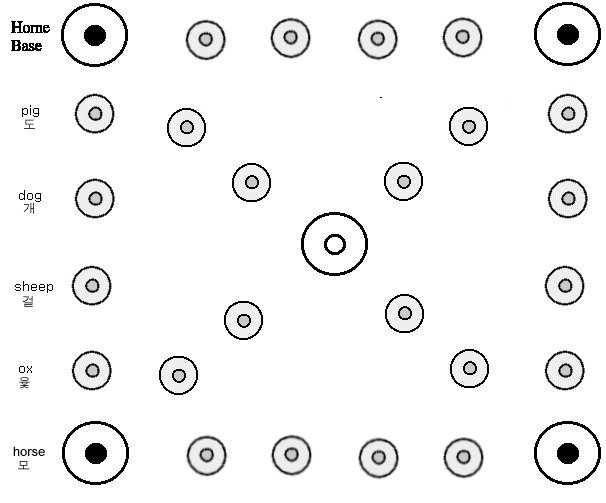Ute-No-Ri has a long tradition in Korea and is traditionally played onTraditional Korean Stick-toss GameYute-No-Ri
Lunar New Year, but it can be enjoyed at any time of the year. There
are four ute sticks, called "ute karak," which look like short wooden
dowels cut in half lengthwise so that they are flat on one side and
round on the other. The ones you buy are usually about 15 cms long
and are tapered slightly toward the ends.
You'll need a mat on which to throw the sticks. When playing
outdoors, Koreans usually use a straw mat or an old straw rice sack
spread out over a flat space on the ground. A blanket folded
in half
or quarters will do indoors.
Each team needs four tokens to move around the board. The object of
the game is to be the first team or player to get all four tokens all
the way around the board and off at the end. Almost anything
small
can be used as tokens-Paduk stones, coins, buttons, chess pieces-as
long as you can tell the teams' tokens apart.
The board is so simple that it can even be drawn freehand right on the
spot, but most people will have prepared or bought a carefully drawn
one in advance.
The path drawn on the board has twenty spaces around the perimeter:
four corner spaces, 3 shortcuts and home base: four spaces along
each edge between the corner spaces, and a center shortcut space,
having 2 spaces connecting it to each corner space. Usually the path
is square, but you may draw it in almost any shape as long it has the
requisite number of spaces.
To determine who goes first, a person of each team throws two of the
sticks and the team with the most points begins: two rounded sides
up
beats two flat sides up, and one of each always loses. Another way
to
decide who goes first is to play "Paper-Scissors-Rock."
Here's how you throw and count during the game:
The sticks are tossed into the air so that they land
on the mat.
If a stick goes completely off the mat, the toss
is invalid.
The count is the number of flat sides facing up,
unless all four
sticks land round side up, in which case the count
is five.
Instead of the usual names for the numbers, Koreans
use some
ancient words for animals:
toe (pig), for one;
kae (dog), for two;
kol (sheep), for three;
ute (ox), for four; and
moe (horse), for five.
If the count is ute or moe you can take an extra throw before moving
a token, counting the extra throw in your move.
Tokens begin by moving onto the space next to home base (pig), which
counts as one. The play continues counterclockwise around the board.
The move is always the same number of spaces as the count for the
throw. Any token on the board of that team may be moved. Counts for
extra throws can be used in any order and can be divided among the
tokens or used for one token.
If you land on a corner or shorcut, you must take the shortcut. If you
land on your own tokens you must move them together. If you land on
an
opponets token, it is removed from the board and must start over again.
In addition, you take another throw. Going around the board and landing
on home base is not enough to win the game: you must have at least
one more count to take the token off the board.
There are variations to the game. One stick can be marked on the flat
side. The mark stands for baekdo or to move back one space. Also,
gambling is permitted and usually welcome, though not when children
are playing.
Some of this information was taken from Hungbo's Gourd, by Gary
Rector, Korea Herald, Monday, February 1, 1999.
